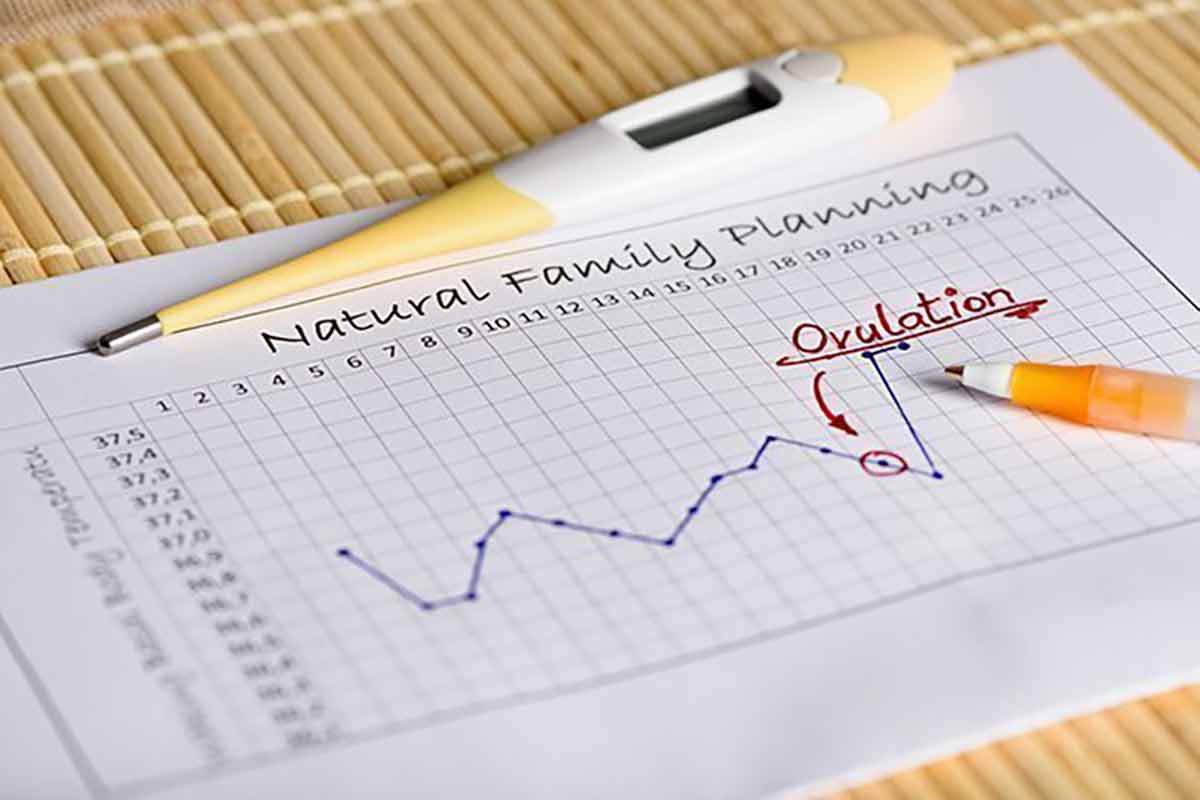This post will help you understand ovulation and ovulation symptoms that occur during your menstrual cycle. At the beginning of your cycle follicle stimulating hormone (FSH) is produced by the pituitary gland in your brain. Each follicle contains one immature egg. Ovulation occurs when an egg is released from one of your ovaries. Ovulation typically happens once a month, in the middle of your menstrual cycle. This means that you are most fertile during the five days prior to ovulation and on the day of ovulation. On ovulation day, the progesterone is secreted to prepare the body for pregnancy in case the released egg is fertilised.
Can you feel ovulation happening? It can be hard to know when exactly you are ovulating. To figure it out, you can track common ovulation symptoms such as changes in your basal body temperature, in your cervical mucus, and to your cervix. There are also other symptoms that may be less common but also occur in many women of reproductive age.
Symptoms before ovulation
If we count day 1 of the menstrual cycle as the day you first start to bleed, around day 7 of the cycle your hormone levels begin to change in order to prepare your ovaries to release an egg. From days 7 to 11, your uterine lining starts to thicken in preparation for an egg to potentially attach to it. During this time you may notice some pre-ovulation symptoms such as a slightly bigger volume of vaginal discharge, and possibly a change in its consistency.
After approximately day 11 in the cycle, the luteinizing hormone triggers the egg to be released from the ovary. The egg begins its journey into the fallopian tube, all the way to your womb (uterus). At around day 14 of your cycle, when the egg has been released, the phase known as ovulation starts.
Top 3 symptoms of ovulation
There are some physical symptoms of ovulation that occur during your menstrual cycle around ovulation time. They may be hard to spot if you are not sure what to look out for but almost all women have these three ovulation symptoms:
- Changes in basal body temperature (BBT). Your BBT is your lowest body temperature in a 24-hour period. On the day after you ovulate, your BBT will go up by 0.5 to 1.0 degree Fahrenheit and stay elevated until your next menstrual period.
- Changes in cervical mucus. Cervical mucus is the vaginal discharge you sometimes find in your underwear. During the few days before you ovulate and immediately after ovulation, you may notice an increase in cervical mucus and a change in its texture. At that time, it may resemble the texture of egg white.
- Changes to the cervix. In addition to cervical fluid variations, during ovulation, your cervix is softer, higher, wetter, and more open.
Weird ovulation symptoms
The following symptoms are not as common or consistent as the ones described above, so you may have all, some, or none of them. They may include:
- Breast tenderness
- Mild cramps or twinges in the lower abdomen, or a one-sided backache, known as mittelschmerz (German for “middle pain”)
- Very light spotting (vaginal bleeding or discharge that may occur when an egg is released)
- Heightened sense of smell
- Increased libido (some women say they feel sexy, flirty, more sociable, and more physically attractive)
- Changes in appetite. Being moody or emotional
- Fluid retention
There are ovulation predictor kits and fertility monitor kits available on the market to help you predict ovulation. They measure the rise of estrogen in your urine. You should know that estrogen levels rise in your body in the days just before when LH peaks (the luteinising hormone). Estrogen helps your body prepare for ovulation. Your womb lining is getting thicker and sperm-friendly cervical mucus appears. The estrogen surge indicates that you are entering your fertile window. Since each woman has a very unique menstrual cycle (and her cycles can vary per month) the ovulation predictor kits take out the guesswork for pinpointing the ovulation. Such fertility monitors can be especially useful if you have difficulty conceiving naturally, and before you consult your physician.
What ovulation symptoms should you look out for?
Start by observing your body during your menstrual cycle and note down the symptoms you have. Keep a track of them in your calendar. With time, it will be easier for you to identify when you are ovulating. What should you look out for? There are a number of symptoms that typically occur around ovulation time. These are:
- Abdominal bloating
- Cramping on just one side of your pelvis
- An increased sex drive
- Headaches
- Mild nausea
- Bloating
- Tender breasts
- Heightened senses such as vision, taste, or smell
- Ovulation pain
Many women experience a variety of secondary ovulation symptoms, however, these can be inconsistent throughout a woman’s life.
Early ovulation symptoms
The early ovulation symptoms are the ones that you can use to help predict your ovulation. These can include basal body temperature change, fertile saliva ferning pattern, ovulation pain, fertile cervical position, fertile quality cervical mucus or increased sexual desire.
Basal body temperature (BBT) is your body temperature at rest. At the start of your cycle, BBT remains fairly consistent and can reach 97.2-97.6 degrees Fahrenheit (36.2-36.4 degrees Celsius). The closer you are to ovulation, the lower basal body temperature. Typically, just after ovulation, your BBT will rise by 0.4-1.0 degrees. If you wish to know if you’re ovulating, track your basal body temperature over a few cycles. This way you should be able to predict it after you notice the drop in the temperature.
Have you heard of a fertile saliva ferning pattern? It has been confirmed that estrogen and progesterone change the consistency of dried saliva before (or during ovulation). In some women, dried saliva will form patterns similar to fern or crystals. There are home-use saliva tests (ovulation predictor) available on the market and they claim to help pinpoint ovulation 2 to 3 days in advance. However, please note that smoking, drinking, eating, and brushing your teeth can mask these effects, making this a not very reliable ovulation predictor.
Peak ovulation symptoms
The easiest to spot symptom that marks the peak of your ovulation is the change in your cervical fluid. Certainly, not all cervical fluids look the same, however, the days when a woman has the most amount of wet fluid marks the peak of ovulation or that ovulation is just about to occur. The fluid will have the consistency of an egg white.
Also, other peak ovulation symptoms include a slight drop in your basal body temperature and a change in cervical position and firmness. At the ovulation peak, the cervix will be wet, high, soft ad open. It may take some time for you to learn to notice this symptom but it is possible to observe it if you practice for a few months.
How long do ovulation symptoms last?
Many women experience ovulation symptoms for up to five days before ovulation and on the day of ovulation. The symptoms may also last for a day after ovulation. However, if you do not observe any signs that you are going through ovulation, do not worry — it doesn’t necessarily mean you are not ovulating. Not all women may notice their ovulation symptoms.
Successful ovulation symptoms
If you notice any of the above-mentioned ovulation symptoms, you can safely assume that you have has successful ovulation. However, if you don’t see a slight increase in your basal body temperature, you may not be ovulating. Though, still, some women don’t experience a temperature rise even if they have successful ovulation. The reason for that remains unknown, but we know that not having a regular sleep pattern and not taking your temperature at the same time every morning can show untrue results.
If you are worried that you may not have successful ovulation, try an ovulation test kit that detects LH hormone. If your result is always negative, it means you are not ovulating. Then, consult your gynecologist for further tests and treatment steps.
Symptoms of ovulation – FAQ
When do you ovulate?
Generally, you ovulate in the middle of your menstrual cycle. A normal menstrual cycle lasts 28 days. If you have a regular cycle, you may ovulate around day 14. However, the lengths of normal cycles can vary from 21 to 35 days; what is more, many women have irregular menstrual cycles. Therefore, some women ovulate around the same day each cycle, but for others, the timing is hard to pinpoint, and some may have irregular ovulation.
Why am I so tired 3 days after ovulation?
Feeling tired 3 days after ovulation can be due to hormonal changes. After ovulation, progesterone levels go up, which can make some women feel more tired. Stress or lifestyle changes can also add to this fatigue.
Will every woman experience the same symptoms of ovulation?
Not every woman will experience symptoms of ovulation. The symptoms can also vary between different women and at different stages in life. Therefore, it is best to use these methods alongside an ovulation calendar if you are truly determined to get pregnant.
Can understanding the symptoms of ovulation help you conceive?
Having sexual intercourse in the three days leading up to ovulation, and including ovulation day will dramatically increase your chances of getting pregnant. These days represent the most fertile time in your menstrual cycle. This is, so-called, a fertile window that is the day an egg is released from the ovary and the five days beforehand. These six days reflect the lifespan of sperm which can survive for up to five days and the lifespan of the egg which is 24 hours.

Are headaches a sign of ovulation?
You may experience a range of symptoms in the second half of your menstrual cycle. This period of time after ovulation and before bleeding begins may trigger things like headache, fatigue, and nausea. The usual cramps and headaches may also make you feel sick to your stomach and generally unwell.
Therefore, if you have not been tracking your cycle or paying close enough attention to your body, you should consider beginning this process. The quicker you become more attuned to your body’s cycle and ovulation signs, the better your chances of conceiving.
Are mood swings one of the ovulation symptoms?
Immediately after ovulation, your estrogen levels drop rapidly. This can make you feel irritable or emotional for a few days until estrogen and progesterone levels start to go up again. Changes in estrogen and progesterone levels have an effect on your serotonin levels, which is a neurotransmitter that helps regulate your mood, sleep cycle, and appetite. Low serotonin level is linked to feelings of sadness, irritability, anxiety, or anger. During that time you may have trouble sleeping and have unusual food cravings — these are common PMS symptoms.
Mood changes are also common symptoms during ovulation and are caused by the hormonal changes that occur in your body. It makes some women feel moodier than usual, but, again, not all women may experience mood swings during ovulation. Some may experience some mood changes only after ovulation, that is during PMS. It is highly individual.
Are cold symptoms during ovulation possible?
Can your menstrual cycle make you feel like you have a cold? Surprisingly, it is quite common for women to experience cold-like or flu-like symptoms and even a higher body temperature between ovulation and the start of their period.
Women call it “the period cold”. Its symptoms can include headaches, a runny nose and a sore throat, body aches, fatigue, etc. If you experience such symptoms and they are always cyclical, they might be “the period cold”.
Why does it happen? According to the findings, the high estrogen levels during ovulation lower the activity of your immune system and that is why, during this time, you can be more prone to infections by various pathogens causing cold or flu, but also infections like herpes, HIV, and HPV.
Can you have ovulation symptoms and not ovulate?
You may assume that if you have your period and/or symptoms described above, it can be a sign that you are ovulating normally. However, it is not always the case. Some women experience anovulation or the lack of ovulation in a menstrual cycle. This is when you have monthly bleeding but this is not technically a menstrual period and an egg has not been released beforehand. Anovulation may occur in women in their prime conception years and is not that uncommon.
Ovulation symptoms – final thoughts
We hope this article will help you understand more about ovulation symptoms and to know when you are ovulating. Once you know what to look out for, it will be surprisingly easy for you to spot ovulation time. If you are trying to get pregnant, recognizing and noticing your ovulation symptoms will also be crucial for your fertility journey.
Frequently Asked Questions Answered by an Expert

We have asked Kate Davies to answer the Frequently Asked Questions about ovulation symptoms. Kate is a Registered Nurse, registered in the UK, a Fertility Nurse Consultant, and a Director of Your Fertility Journey. She has been working in the health field for over 20 years.
How do you know if you are ovulating?
The best and most accurate way to know if you are ovulating is to become empowered and knowledgeable about your body. We tend to assume that we always ovulate on day 14 of a menstrual cycle but that is often not the case, particularly if you have longer or shorter cycles. These days there are many different types of Apps and Monitors that can help you to get to know your body better. However, these can vary hugely in accuracy and therefore it’s best to get to grips with the basics.
You might be interested in: Apps for family planning
What are the three signs of ovulation?
Mother nature has given us three accurate fertility signs to help identify when we’re ovulating. These recognised signs are – temperature, cervical mucous, and changes in the position of your cervix. Is this the first you’ve heard about this? If so, you’re not alone. We’re not told about it in school, as that’s all about avoiding getting pregnant, and it might not be until you’ve been trying to conceive for a while that you stumble across something to do with your temperature on a fertility blog or forum or over a whispered coffee and chat with a friend.
Let’s look at these three signs one by one:
Basal Body Temperature (BBT)
A woman’s body temperature rises immediately following ovulation as the result of increasing progesterone levels in the bloodstream. Charting your temperature can help you look for a pattern and help you to see when ovulation has occurred. A temperature rise is an indication that you have ovulated, however as the life of the egg is very short, 12-24 hours, you also need to know WHEN ovulation is likely to occur. To do this you need to monitor another fertility indicator at the same time, either cervical mucous or the cervix.
Cervical Mucous
Throughout the month a woman’s cervical secretions change from no secretions (known as ‘dry days’) in the early cycle to thicker, dryer ‘non-fertile’ secretions and eventually the thinner and wetter ‘fertile secretions’. Once you get used to what is normal for you, this method is a very reliable way of determining when you become fertile, and along with your temperature, when you ovulate.
Position of the Cervix
The final recognised fertility sign is the cervix. The cervix changes in feel and position throughout the cycle. When you’re not fertile the cervix is low in the vagina, easy to feel and feels quite hard – like the end of your nose. As you start to become fertile, the cervix rises higher in the vagina and feels softer – like your ear lobe. This method is a little more complex to learn and not every woman feels comfortable in feeling for the cervix, but if you struggle to notice cervical mucous, you may find it useful.
How does a woman feel during ovulation?
Every woman is individual, and you may not notice feeling any different to normal during ovulation. Some women notice they have increased libido around ovulation. Some might notice breast tenderness, mild cramps, bloating or light spotting. It’s perfectly normal to have none, some or all of these symptoms. Whilst these may be due to ovulation, the subjective nature of these symptoms and that they could be based on pure coincidence, means that they are not reliable indicators of ovulation.
How can I check my ovulation at home?
Apart from observing the recognised fertility signs, you can choose to invest in a fertility monitor. There are many different types of monitors, from those that observe skin temperature, core body temperature or hormones in your urine. The key here is finding out what is right for you. Do your research and find which is most accurate and reliable as well as which one may fit your budget best.
Monitors which observe your urine – ovulation predictor kits are a popular option. OPK’s determine whether luteinising hormone (LH) is detected in the urine. LH rises right before ovulation occurs, and therefore OPK’s detect that ovulation is going to occur. However, women with conditions such as PCOS or diminished ovarian reserve have higher levels of LH and therefore OPK’s can give false results.
Can ovulation symptoms last a week?
As ovulation is very short – 12-24 hours then you are most likely to notice your symptoms for just a few days. However, it is worth noting here that, despite that the egg once ovulated is only around for 12-24 hours, the life of the sperm is a lot longer. Sperm can live in the vagina for 5 days on average (and in some circumstances a day or two longer!). Therefore, any sex that occurs in the lead up to ovulation could result in a pregnancy.
Can ovulation symptoms vary from month to month?
Yes, absolutely. Some months you may not notice any symptoms at all and other months a whole host. It’s all down to our hormones and how these can vary month to month.
Can ovulation symptoms mimic pregnancy?
Some women experience breast tenderness at ovulation and this is due to the increase in the hormone progesterone in the blood stream. This breast tenderness may continue and can be a little confusing, making you wonder if you have conceived. However, in general, pregnancy symptoms don’t occur until a little while after a missed period.
What are the ovulation symptoms with PCOS?
Women who have PCOS may have longer cycles and therefore ovulate less frequently or in some circumstances, not ovulate at all. When ovulation occurs, you may notice the same ovulatory symptoms as discussed above, however you might find it more difficult and confusing to accurately monitor your symptoms and ovulation signs. Seeking help from your doctor or a PCOS specialist can help you understand your body better and help you to know more about your fertility with PCOS.
How can you tell the difference between ovulation symptoms and PMS?
Because the symptoms, such as breast tenderness and crampy pain can be similar, it can be a little confusing to tell the difference. By tracking your cycle to understand where in your cycle you are, for example coming up to ovulation or nearer to your period, along with identifying your fertile signs, will help you to understand your body better and know the difference between ovulation and PMS.
What are ovulation symptoms without ovulating?
Some women, particularly those with ovulatory disorders such as PCOS, may have a cycle where no ovulation occurs. During this cycle, it is possible to experience some of the symptoms of ovulation as the body tries to ovulate but is unsuccessful.




